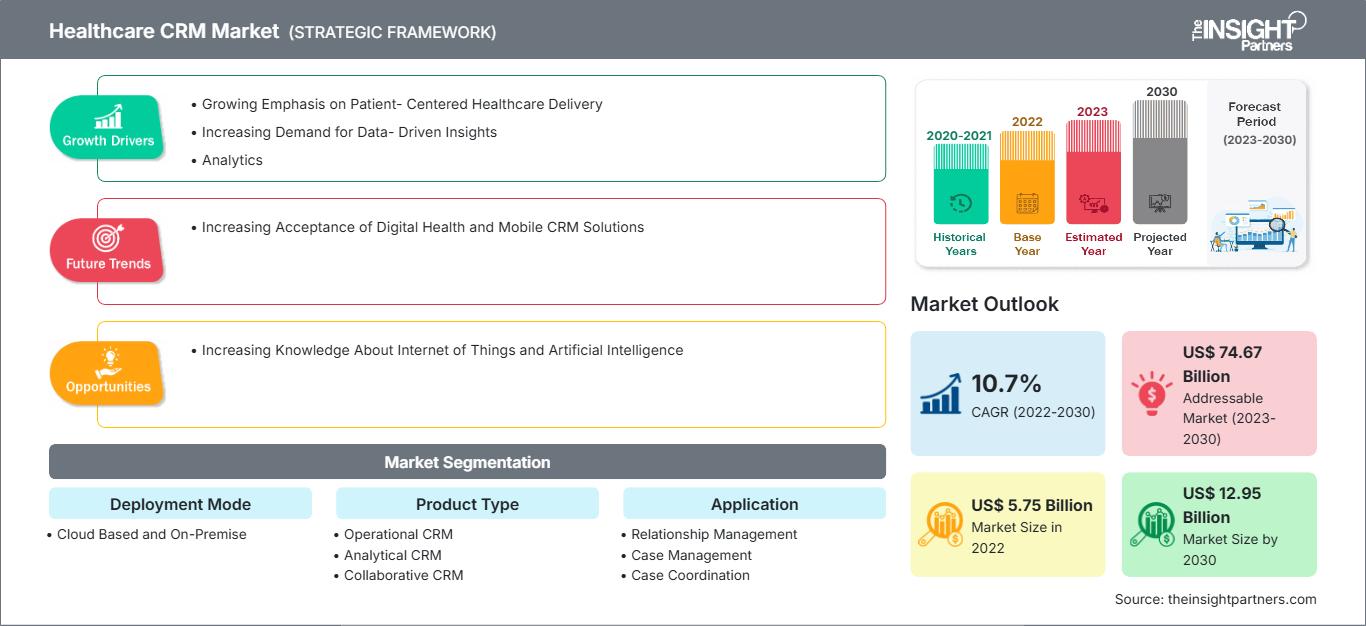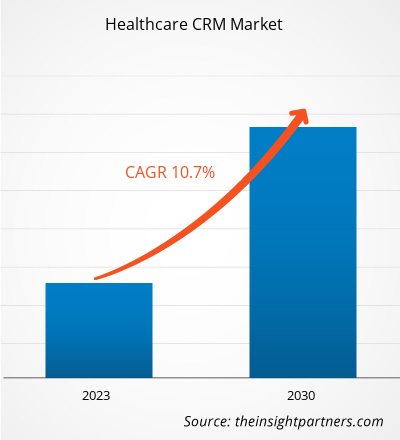[研究报告] 预计医疗保健 CRM 市场规模将从 2022 年的 57.5095 亿美元增长至 2030 年的 129.4715 亿美元,2022 年至 2030 年的复合年增长率为 10.7%。
市场洞察与分析师观点:
医疗保健 CRM 是一个行业特定的系统,可帮助医疗服务提供商存储和管理患者信息、改善服务和参与度、改进患者获取策略以及自动化营销和销售运营,同时遵守医疗保健安全标准。推动医疗保健 CRM 市场增长的关键因素包括对以患者为中心的医疗保健服务的日益重视,以及对数据驱动的洞察、分析和人口健康管理日益增长的需求。然而,数据安全性的缺乏以及与患者信息隐私相关的担忧阻碍了医疗保健 CRM 市场的增长。
增长动力与制约因素:
以患者为中心的医疗保健体系能够在患者、家属和医护人员之间建立合作关系,从而根据患者的需求、偏好和要求做出协调一致的决策。这还包括为患者提供具体的教育和支持,帮助他们做出特定决策并参与到护理中。
加强与所有利益相关者(医疗服务提供者、患者及其他相关方)的互动,可以降低总体成本。此外,患者对健康、福祉和医疗保健选择的知识和理解的提升,可以改善护理质量并降低患病率。这种知识的提升可以促进出院后护理、医院就诊、减少再入院率以及二次咨询。通过与患者互动并共同参与决策,医疗服务提供者可以就患者的健康状况做出更合适的决策。随着越来越多的医院在医疗质量和成本方面争夺患者,竞争优势也随之增强。患者生活质量的提高会提高医生和患者的满意度。
自定义此报告以满足您的要求
您将免费获得任何报告的定制,包括本报告的部分内容,或国家级分析、Excel 数据包,以及为初创企业和大学提供超值优惠和折扣
医疗保健 CRM 市场: 战略洞察

-
获取本报告的主要市场趋势。这个免费样本将包括数据分析,从市场趋势到估计和预测。
技术创新和软件开发对医疗保健行业革命至关重要。这些技术发展支持医疗和管理服务,极大地增强和简化了医疗保健流程、沟通和工作流程。以患者为中心的医疗保健提高了患者满意度,从而使医疗保健提供者和医疗机构受益。因此,医疗保健提供者越来越多地采用以患者为中心的方法,推动了医疗保健 CRM 市场的增长。
然而,存储在 CRM 门户中的敏感健康数据的保护是医疗保健提供者和护理接受者关注的主要问题。由于操作 CRM 的最终用户可能会将个人数据出售给第三方,患者担心其私人数据(可能包括其生物数据)的隐私问题。此外,如果这些设备连接到患者的医疗账单记录,风险可能进一步导致财务数据泄露。根据《健康保险流通与责任法案》(HIPAA) 期刊的报道,2009 年至 2022 年间,美国卫生与公众服务部 (HHS) 民权办公室共收到 5,150 起医疗保健数据泄露事件,涉及超过 500 条记录。这些数据泄露事件已暴露或非法披露了 382,262,109 份医疗记录,相当于美国总人口的 1.2 倍以上。2022 年,平均每天报告 1.94 起数据泄露事件,涉及 500 条或以上的医疗记录。尽管科技公司投入巨资增强产品安全性,但消费者可能需要一段时间才能完全依赖软件进行医疗相关活动。因此,数据安全和隐私相关问题限制了 CRM 软件的普及,从而阻碍了市场增长。
趋势:
医疗保健领域对数字医疗和移动客户关系管理 (CRM) 解决方案的接受度日益提高,这正在重塑医疗保健 CRM 的格局,从而推动了对创新平台的需求,这些平台旨在简化患者参与、虚拟医疗服务和移动医疗协调。数字医疗日益普及,有助于医疗行业利用数字渠道、移动技术和更优质的患者体验,优化医疗服务质量并提高患者满意度。
数字医疗在医疗基础设施中的普及影响着护理协调工具、安全消息平台和远程护理协调能力的整合,从而支持多渠道护理互动,促进医患沟通,并增强患者在不同接触点的参与度。此外,移动技术和应用的快速发展、将移动医疗融入现有电子医疗服务的新机遇以及移动蜂窝网络覆盖范围的不断扩大,都是推动移动CRM等移动医疗解决方案普及的主要因素。根据国际电信联盟 (ITU) 的估计,2020年全球无线用户超过50亿,其中超过70%生活在中低收入国家。根据GSM协会的数据,商业无线传输已覆盖全球约85%的人口,远远超出了电网的覆盖范围。无线通信的普及将有助于提高护理质量和患者健康,并通过简单地协助解决远程患者监控和医疗安排等问题,每年节省大量不必要的医疗成本。移动医疗的应用在未来几年可能会扩展。据 Salesforce 称,约 52% 的医院使用三种或更多种互联医疗技术,其中 58% 的医院配备了针对移动设备优化的患者门户。因此,移动医疗解决方案应用的不断增长以及全球数字医疗日益普及将增加各种医疗基础设施对医疗 CRM 的需求。
报告细分和范围:
全球医疗保健 CRM 市场根据部署模式、产品类型、应用和最终用户进行细分。根据部署模式,市场分为基于云的 CRM 和本地部署的 CRM。根据产品类型,市场分为运营型 CRM、分析型 CRM 和协作型 CRM。按应用,医疗保健 CRM 市场分为关系管理、案例管理、案例协调、社区拓展和其他。就最终用户而言,医疗保健 CRM 市场细分为提供商、付款方和其他方。从地理区域来看,医疗保健 CRM 市场细分为:北美(美国、加拿大和墨西哥)、欧洲(德国、法国、意大利、英国、俄罗斯和欧洲其他地区)、亚太地区(澳大利亚、中国、日本、印度、韩国和亚太其他地区)、中东和非洲(南非、沙特阿拉伯、阿联酋和中东及非洲其他地区)以及南美洲和中美洲(巴西、阿根廷和南美洲和中美洲其他地区)。
细分分析:
根据部署模式,医疗保健 CRM 市场细分为基于云的部署和本地部署。 2022 年,云端 CRM 市场占据了更大的份额,预计 2022 年至 2030 年期间的复合年增长率将更高。云端医疗 CRM 解决方案托管在供应商的服务器上,并通过 Web 浏览器访问。云端 CRM 解决方案提供无与伦比的可访问性,使医疗专业人员能够从任何有互联网连接的地方访问患者数据和 CRM 工具。这种灵活性对于远程办公或跨地办公的医疗服务提供者尤为宝贵。
按产品类型,医疗 CRM 市场可细分为分析型 CRM、协作型 CRM 和运营型 CRM。2022 年,运营型 CRM 市场占据了最大的份额,预计 2022 年至 2030 年期间的复合年增长率将最高。运营型 CRM 专注于简化和自动化医疗机构内的运营流程,例如预约安排、患者登记、计费和理赔处理。这些解决方案可帮助医疗保健提供商提高效率、减轻管理负担并提升整体患者体验。
按应用细分,医疗保健 CRM 市场可分为病例管理、关系管理、社区拓展、病例协调等。关系管理细分市场在 2022 年占据了最大的市场份额,预计在 2022 年至 2030 年期间将实现最高的复合年增长率。医疗保健 CRM 市场中的关系管理侧重于与患者、护理人员和其他利益相关者建立并维持牢固的关系。
按最终用户细分,医疗保健 CRM 市场可分为提供商、付款方和其他方。 2022 年,医疗服务提供商占据了最大的市场份额,预计在 2022 年至 2030 年期间将实现最高的复合年增长率。包括医院、诊所和个人医疗保健专业人员在内的服务提供商需要 CRM 解决方案来帮助他们管理病例、协调护理并与患者建立牢固的关系。
区域分析:
从地理上讲,医疗保健 CRM 市场分为北美、欧洲、亚太地区、南美和中美以及中东和非洲。2022 年,北美占据了全球医疗保健 CRM 市场的最大份额。预计亚太地区在 2022 年至 2030 年期间的复合年增长率最高。
美国大多数医院和诊所都面临着财务和运营压力。医疗保健 CRM 软件主要与医院、诊所和门诊手术中心合作,用于安排和管理预约,尤其是在急诊科,以及门诊、住院和外科部门的低效预约。高效的患者预约管理仍然是大多数医院和诊所面临的紧迫问题。由于医疗预约不当,患者在公立和私立医疗系统中接受优质护理时会遇到延误。2022 年关于医生预约等待时间以及医疗保险和医疗补助接受率的调查显示,首次预约医生的平均等待时间为 26 天,比 2017 年(平均等待时间约为 24 天)增加了 8%。这导致等待时间延长、预约困难以及公立和私立医疗部门的供需失衡。医疗保健 CRM 软件使医院和诊所能够跟踪患者的到达和离开情况,并实时了解共付额和取消预约的情况。使用软件可以通过预约提醒电话将爽约率降低 30%。它增强了整个治疗流程,并改善了与患者的沟通。
此外,美国报告的慢性病和急性病患病率很高。根据美国心脏协会的《心脏病和中风统计 - 2023 年更新》,冠心病 (CHD) 是 2020 年美国心血管疾病相关死亡的主要原因 (41.2%),其次是中风 (17.3%)、其他心血管疾病 (16.8%)、高血压 (12.9%)、心力衰竭 (9.2%) 和动脉疾病 (2.6%)。根据美国疾病控制和预防中心 (CDC) 的数据,美国 20 岁及以上成年人中约有 1/20 患有冠状动脉疾病。因此,心血管疾病和其他慢性病的高患病率推动了美国对医疗排程和医疗保健 CRM 的采用的需求。此外,预计美国医疗保健 IT 的快速采用将推动未来医疗保健 CRM 市场的增长。
医疗保健 CRM 市场区域洞察
The Insight Partners 的分析师已详尽阐述了预测期内影响医疗保健 CRM 市场的区域趋势和因素。本节还探讨了北美、欧洲、亚太地区、中东和非洲以及南美和中美洲的医疗保健 CRM 市场细分和地域分布。
医疗保健 CRM 市场报告范围
| 报告属性 | 细节 |
|---|---|
| 市场规模 2022 | US$ 5.75 Billion |
| 市场规模 2030 | US$ 12.95 Billion |
| 全球复合年增长率 (2022 - 2030) | 10.7% |
| 历史数据 | 2020-2021 |
| 预测期 | 2023-2030 |
| 涵盖的领域 |
By 部署模式
|
| 覆盖地区和国家 |
北美
|
| 市场领导者和主要公司简介 |
|
医疗保健 CRM 市场参与者密度:了解其对业务动态的影响
医疗保健 CRM 市场正在快速增长,这得益于终端用户需求的不断增长,而这些需求的驱动因素包括消费者偏好的不断变化、技术进步以及对产品优势的认知度不断提高。随着需求的增长,企业正在扩展其产品线,不断创新以满足消费者需求,并利用新兴趋势,从而进一步推动市场增长。

- 获取 医疗保健 CRM 市场 主要参与者概述
全球医疗保健 CRM 市场主要参与者的各项举措如下:
- 2023 年 8 月,IBM 和 Salesforce 宣布合作,帮助全球各行各业的企业加速采用人工智能 (AI) 进行 CRM 转型。两家公司携手合作,支持客户革新客户、合作伙伴和员工体验,同时保护他们的数据安全。
- 2022 年 4 月,Cured 宣布推出其专为医疗保健打造的数字营销和客户关系管理 (CRM) 平台的新一代产品,进一步助力公司履行“全方位医疗”的使命。这些平台的进步使医疗保健机构能够与新客户和现有患者建立无与伦比的关系。
- 2021 年 11 月,Pegasystems Inc. 与 Google Cloud 合作,通过更深入的数据洞察和个性化服务,提升了医疗保健体验。 Pega 与 Google Cloud 的此次合作将 Google Cloud 的医疗数据引擎与 Pega 的智能医疗解决方案套件的功能完美融合。
竞争格局和主要公司:
Pegasystems Inc、Sage Group Plc、IQVIA Holdings Inc、VerioMed Corp、Pipedrive Inc、WebMD Ignite Inc、Zendesk Inc、SugarCRM Inc、SAP SE、Veeva Systems Inc、Oracle Corp、ScienceSoft USA Corp、Microsoft Corp、Salesforce Inc 和 International Business Machines Corp 是医疗 CRM 市场的杰出参与者。这些公司专注于新技术、现有产品的改进和地域扩张,以满足全球不断增长的消费者需求,并扩大其专业产品组合的范围。
- 历史分析(2 年)、基准年、预测(7 年)及复合年增长率
- PEST和SWOT分析
- 市场规模、价值/数量 - 全球、区域、国家
- 行业和竞争格局
- Excel 数据集
近期报告
相关报告
客户评价
购买理由
- 明智的决策
- 了解市场动态
- 竞争分析
- 客户洞察
- 市场预测
- 风险规避
- 战略规划
- 投资论证
- 识别新兴市场
- 优化营销策略
- 提升运营效率
- 顺应监管趋势






















 获取免费样品 - 医疗保健 CRM 市场
获取免费样品 - 医疗保健 CRM 市场